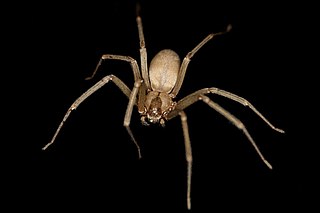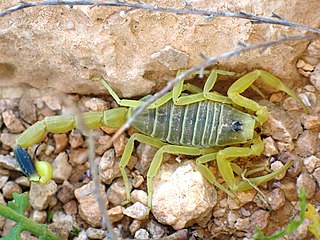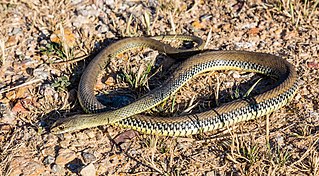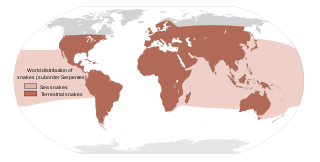
The brown recluse, Loxosceles reclusa, Sicariidae is a recluse spider with a necrotic venom. Similar to other recluse spider bites, their bite sometimes requires medical attention. The brown recluse is one of three spiders with medically significant venom in North America.

The Portuguese man o' war, also known as the man-of-war, or blue bottle is a marine hydrozoan found in the Atlantic, Indian and Pacific Oceans. It is one of two species in the genus Physalia, along with the Pacific man o' war, Physalia utriculus. Physalia is the only genus in the family Physaliidae. Long tentacles have numerous venomous microscopic nematocysts which deliver a painful sting powerful enough to kill fish and even occasionally humans. Despite its appearance, the Portuguese man o' war differs from most animals called jellyfish which are single organisms. The Portuguese man o' war is classified as a siphonophore, a colonial organism made up of many specialized parts called zooids. These zooids are attached to one another, physiologically integrated and cannot survive independently. The assemblage of zooids works together to function as an individual animal.

The king cobra, also known as the hamadryad, is a venomous snake species in the family Elapidae, endemic to forests from India through Southeast Asia. It is threatened by habitat destruction and has been listed as Vulnerable on the IUCN Red List since 2010. It is the world's longest venomous snake. Adult king cobras are 3.18 to 4 m long. The longest known individual measured 5.85 m (19.2 ft). It is the sole member of the genus Ophiophagus. It preys chiefly on other snakes and occasionally on some other vertebrates, such as lizards and rodents. It is a highly venomous and dangerous snake when agitated or provoked that has a fearsome reputation in its range, although it is typically shy and avoids confrontation with humans when possible. The king cobra is a prominent symbol in the mythology and folk traditions of India, Sri Lanka and Myanmar. It is the national reptile of India.

Atracidae is a family of mygalomorph spiders, commonly known as Australian funnel-web spiders or atracids. It has been included as a subfamily of the Hexathelidae, but is now recognized as a separate family. All members of the family are native to Australia. Atracidae consists of three genera: Atrax, Hadronyche, and Illawarra, comprising 35 species. Some members of the family produce venom that is dangerous to humans, and bites by spiders of six of the species have caused severe injuries to victims. The bite of the Sydney funnel-web spider and northern tree-dwelling funnel-web spider are potentially deadly, but no fatalities have occurred since the introduction of modern first-aid techniques and antivenom.

Box jellyfish are cnidarian invertebrates distinguished by their cube-shaped medusae. Some species of box jellyfish produce extremely potent venom: Chironex fleckeri, Carukia barnesi and Malo kingi. Stings from these and a few other species in the class are extremely painful and can be fatal to humans.

Heloderma, or beaded lizards, are large, stocky, slow-moving reptiles that prefer semi-arid climates. Their tails are short and used as fat storage organs. They are covered with small, non-overlapping, bead-like scales, with osteoderms on the undersides of their bodies. All species are dark in color, with yellowish or pinkish markings. Heloderma is the only living genus of the family Helodermatidae.

Antivenom, also known as antivenin, venom antiserum, and antivenom immunoglobulin, is a medication made from antibodies that is used to treat certain venomous bites and stings. Antivenoms are recommended only if there is significant toxicity or a high risk of toxicity. The specific antivenom needed depends on the species involved. It is given by injection.

A snakebite is an injury caused by the bite of a snake, especially a venomous snake. A common sign of a bite from a venomous snake is the presence of two puncture wounds from the animal's fangs. Sometimes venom injection from the bite may occur. This may result in redness, swelling, and severe pain at the area, which may take up to an hour to appear. Vomiting, blurred vision, tingling of the limbs, and sweating may result. Most bites are on the hands, arms, or legs. Fear following a bite is common with symptoms of a racing heart and feeling faint. The venom may cause bleeding, kidney failure, a severe allergic reaction, tissue death around the bite, or breathing problems. Bites may result in the loss of a limb or other chronic problems. The outcome depends on the type of snake, the area of the body bitten, the amount of venom injected, and the general health of the person bitten. Problems are often more severe in children than adults, due to their smaller size.

The redback spider, also known as the Australian black widow, is a species of highly venomous spider believed to originate in South Australia or adjacent Western Australian deserts, but now found throughout Australia, Southeast Asia and New Zealand, with colonies elsewhere outside Australia. It is a member of the cosmopolitan genus Latrodectus, the widow spiders. The adult female is easily recognised by her spherical black body with a prominent red stripe on the upper side of her abdomen and an hourglass-shaped red/orange streak on the underside. Females usually have a body length of about 10 millimetres (0.4 in), while the male is much smaller, being only 3–4 mm (0.12–0.16 in) long.

The deathstalker is a species of scorpion, a member of the family Buthidae. It is also known as the Palestine yellow scorpion, Omdurman scorpion, Naqab desert scorpion and by many other colloquial names, which generally originate from the commercial captive trade of the animal. To eliminate confusion, especially important with potentially dangerous species, the scientific name is normally used to refer to them. The name Leiurus quinquestriatus roughly translates into English as "five-striped smooth-tail". In 2014, the subspecies L. q. hebraeus was separated from it and elevated to its own species Leiurus hebraeus. Other species of the genus Leiurus are also often referred to as "deathstalkers".
Envenomation is the process by which venom is injected by the bite or sting of a venomous animal.

A spider bite, also known as arachnidism, is an injury resulting from the bite of a spider. The effects of most bites are not serious. Most bites result in mild symptoms around the area of the bite. Rarely they may produce a necrotic skin wound or severe pain.

Naja is a genus of venomous elapid snakes known as cobras. Members of the genus Naja are the most widespread and the most widely recognized as "true" cobras. Various species occur in regions throughout Africa, Southwest Asia, South Asia, and Southeast Asia. Several other elapid species are also called "cobras", such as the King cobra and the Rinkhals, but neither are true cobras. They are not true cobras in that they do not belong to the genus Naja, but instead each belong to monotypic genera Hemachatus (Rinkhals) and Ophiophagus.

Delta atracotoxin is a low-molecular-weight neurotoxic polypeptide found in the venom of the Sydney funnel-web spider.

Synanceia is a genus of fish of the family Synanceiidae, the stonefishes, whose members are venomous, dangerous and even fatal to humans. They are the most venomous fish known. They are found in the coastal regions of the Indo-Pacific.

A stingray injury is caused by the venomous tail spines, stingers or dermal denticles of rays in the order Myliobatiformes, most significantly those belonging to the families Dasyatidae, Urotrygonidae, Urolophidae, and Potamotrygonidae. Stingrays generally do not attack aggressively or even actively defend themselves. When threatened, their primary reaction is to swim away. However, when attacked by predators or stepped on, the stinger in their tail is whipped up. This is normally ineffective against sharks, their main predator.

Malpolon monspessulanus, commonly known as the Montpellier snake, is a species of mildly venomous rear-fanged colubrids.

Hottentotta tamulus, the Indian red scorpion also known as the eastern Indian scorpion, is a species of scorpion of the family Buthidae. It occurs in most of India, eastern Pakistan and the eastern lowlands of Nepal, and recently from Sri Lanka.

Most snakebites are caused by non-venomous snakes. Of the roughly 3,700 known species of snake found worldwide, only 15% are considered dangerous to humans. Snakes are found on every continent except Antarctica. There are two major families of venomous snakes, Elapidae and Viperidae. Three hundred twenty five species in 61 genera are recognized in the family Elapidae and 224 species in 22 genera are recognized in the family Viperidae, In addition, the most diverse and widely distributed snake family, the colubrids, has approximately 700 venomous species, but only five genera—boomslangs, twig snakes, keelback snakes, green snakes, and slender snakes—have caused human fatalities.


















